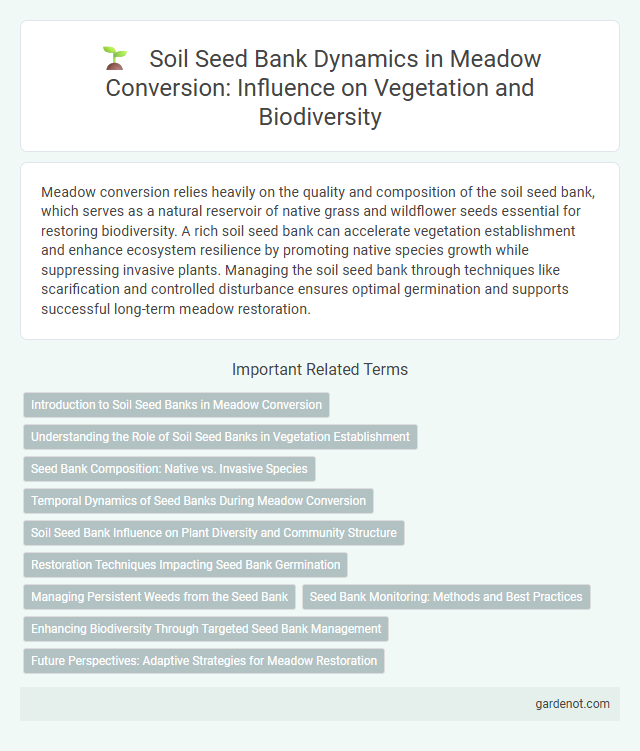Meadow conversion relies heavily on the quality and composition of the soil seed bank, which serves as a natural reservoir of native grass and wildflower seeds essential for restoring biodiversity. A rich soil seed bank can accelerate vegetation establishment and enhance ecosystem resilience by promoting native species growth while suppressing invasive plants. Managing the soil seed bank through techniques like scarification and controlled disturbance ensures optimal germination and supports successful long-term meadow restoration.
Introduction to Soil Seed Banks in Meadow Conversion
Soil seed banks play a crucial role in meadow conversion by serving as reservoirs of native and pioneer plant species that facilitate natural regeneration. These seeds, preserved in the soil from previous vegetation cycles, provide a genetic reservoir critical for restoring biodiversity and ecosystem functions in converted meadows. Understanding the composition and viability of soil seed banks informs management practices that enhance successful meadow establishment and resilience.
Understanding the Role of Soil Seed Banks in Vegetation Establishment
Soil seed banks play a critical role in vegetation establishment during meadow conversion by providing a reservoir of viable seeds that can germinate under favorable conditions. The composition and density of seeds within the soil influence species diversity and succession dynamics, directly affecting ecosystem restoration success. Managing soil seed banks through techniques like soil disturbance and seed augmentation can enhance native plant recruitment and improve long-term meadow resilience.
Seed Bank Composition: Native vs. Invasive Species
Soil seed bank composition in meadow conversion projects is critical, with native species seeds dominating as indicators of a resilient ecosystem while invasive species seeds pose significant risks to biodiversity. Effective meadow restoration relies on assessing seed bank diversity and density, emphasizing native seed prevalence to ensure long-term ecological balance. Monitoring the ratio of native to invasive seeds guides targeted management practices that facilitate native plant establishment and suppress invasive species proliferation.
Temporal Dynamics of Seed Banks During Meadow Conversion
Soil seed banks undergo significant temporal changes during meadow conversion, with seed density and species composition fluctuating seasonally and annually. Early stages often show a dominance of pioneer and disturbance-adapted species, while later phases reveal an increase in perennial and native meadow species as the seed bank stabilizes. Monitoring these dynamics is crucial for predicting plant community succession and guiding effective restoration strategies.
Soil Seed Bank Influence on Plant Diversity and Community Structure
Soil seed banks are critical reservoirs of plant genetic diversity that significantly influence meadow conversion by determining species composition and succession dynamics. The diversity and viability of seeds stored in the soil shape plant community structure, enabling resilience against environmental changes and disturbance. Understanding soil seed bank properties helps predict restoration outcomes and guides management practices to enhance meadow biodiversity.
Restoration Techniques Impacting Seed Bank Germination
Restoration techniques such as soil scarification, controlled burns, and strategic mowing significantly influence the germination rates of the soil seed bank in meadow conversion projects. These methods modify seedbed conditions, light exposure, and nutrient availability, enhancing the emergence of native species while suppressing invasive plants. Effective manipulation of the soil seed bank through targeted restoration practices accelerates meadow recovery and biodiversity restoration.
Managing Persistent Weeds from the Seed Bank
Managing persistent weeds from the soil seed bank is critical for successful meadow conversion, as weed seeds can remain viable for years, undermining native plant establishment. Techniques such as repeated shallow disturbance, targeted herbicide application, and promoting dense native vegetation growth help reduce weed seed viability and emergence. Monitoring seed bank composition guides adaptive management, ensuring long-term control of invasive species during meadow restoration.
Seed Bank Monitoring: Methods and Best Practices
Soil seed bank monitoring in meadow conversion is essential for assessing seed density, diversity, and viability to support successful habitat restoration. Common methods include soil sampling with core extraction, germination trials under controlled conditions, and seedling emergence assessments in situ. Best practices emphasize consistent sampling protocols, temporal replication to capture seasonal variation, and integrating molecular techniques for precise species identification.
Enhancing Biodiversity Through Targeted Seed Bank Management
Targeted seed bank management in meadow conversion enhances biodiversity by promoting the germination of native and ecologically valuable plant species stored in the soil. Strategic disturbance techniques and seed enrichment methods optimize the soil seed bank's potential, resulting in diverse plant communities that support pollinators and wildlife. Monitoring seed viability and composition ensures long-term ecosystem resilience and adaptive capacity in restored meadows.
Future Perspectives: Adaptive Strategies for Meadow Restoration
Soil seed banks play a critical role in meadow conversion by providing a reservoir of native species for natural regeneration and promoting biodiversity resilience. Future perspectives emphasize adaptive strategies such as monitoring seed viability, enhancing seed dispersal mechanisms, and integrating climate-resilient species to ensure successful meadow restoration. Incorporating genetic diversity from local seed banks can improve ecosystem stability and support long-term habitat recovery.
Soil seed bank Infographic

 gardenot.com
gardenot.com